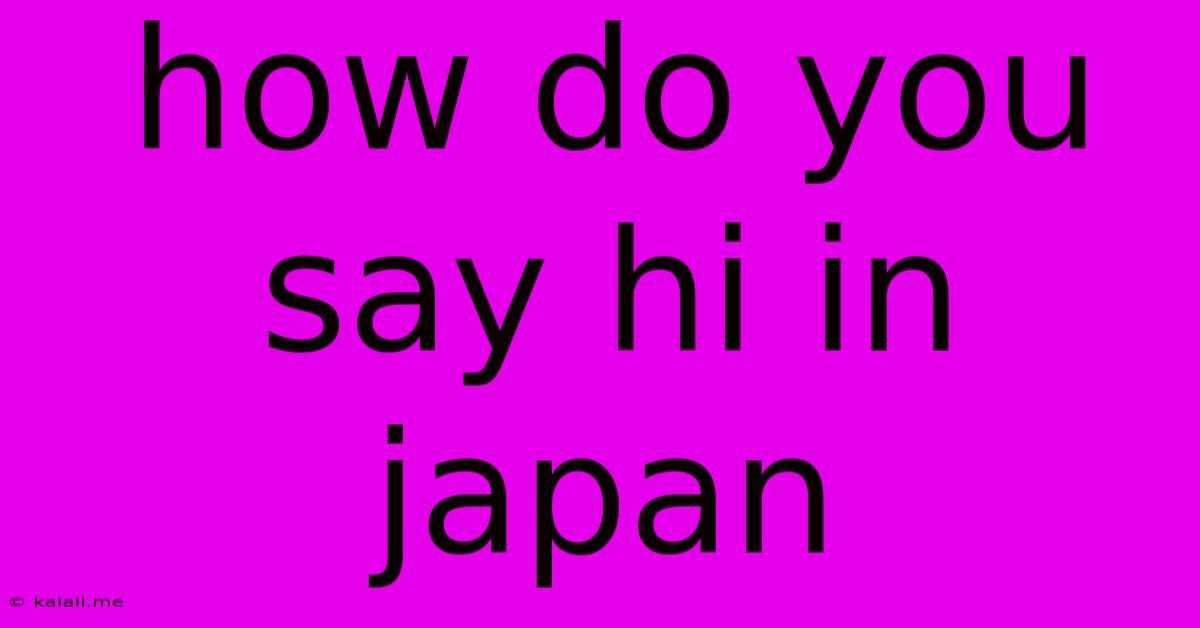How Do You Say Hi In Japan
Kalali
Jun 08, 2025 · 3 min read

Table of Contents
How Do You Say Hi in Japan? A Guide to Japanese Greetings
Saying "hi" in Japan isn't as simple as a single word translation. The appropriate greeting depends heavily on the time of day, your relationship with the person, and the context of the situation. This article explores various ways to greet someone in Japan, ensuring you'll always make a positive first impression. Learning these nuances will enhance your interactions and show respect for Japanese culture.
There's no single perfect equivalent to "hi" in Japanese, but let's explore the most common and useful greetings:
Common Greetings Throughout the Day:
-
おはようございます (Ohayou gozaimasu): This is the standard greeting used from sunrise until around 10 am. It translates to "Good morning," but it's more encompassing than its English counterpart and is suitable for both formal and informal settings. This is likely the most frequently used greeting.
-
こんにちは (Konnichiwa): This is the standard greeting used from around 10 am to sunset. It translates to "Good afternoon" or "Hello," and it's appropriate for most situations, from casual conversations with friends to more formal interactions with colleagues or acquaintances. It's a safe bet for most situations.
-
こんばんは (Konbanwa): Used from sunset onwards, this translates to "Good evening." Like "Ohayou gozaimasu," it's a versatile greeting suitable for various contexts. Avoid using it too early in the evening.
Informal Greetings Among Friends and Family:
-
やあ (Yaa): A casual "hi" or "hey," similar to the English "yo." Only use this with close friends and family.
-
もしもし (Moshi moshi): This is typically used when answering the phone, but in informal settings amongst close friends, it might be used as a casual greeting as well.
-
おっす (Ossu): An extremely informal greeting, primarily used by men, usually among close friends or within a very close-knit group.
Formal Greetings in Business Settings or with Elders:
While Konnichiwa is acceptable in many professional situations, consider these more formal options:
-
Adding です (desu) to the end of a greeting makes it more formal and polite. For example,
Konnichiwa desuis a slightly more formal version ofKonnichiwa. -
Using titles such as 先生 (sensei) for teachers and professors, or 様 (sama) after a person's name (though this is quite formal and rarely used outside of very formal written communications), shows additional respect.
Beyond Verbal Greetings: Bowing
Verbal greetings are often accompanied by a bow. The depth and duration of the bow depend on the social context. A slight nod is appropriate for informal settings, while a deeper bow is more respectful in formal situations. Observe how others greet each other to gauge the appropriate level of bowing.
Practical Tips for Learning Japanese Greetings:
-
Practice makes perfect: Try practicing these greetings aloud to improve your pronunciation.
-
Context is key: Pay attention to the time of day and your relationship with the person you're greeting.
-
Observe and learn: Watch Japanese movies or dramas and listen to Japanese conversations to familiarize yourself with the natural flow of greetings.
-
Don't be afraid to make mistakes: Native speakers will appreciate your effort to learn their language.
Mastering Japanese greetings is a significant step in showing respect and building connections. By understanding the nuances of these greetings, you'll be well-equipped for positive interactions in Japan. Remember to pay attention to the context and adjust your greeting accordingly. Happy communicating!
Latest Posts
Latest Posts
-
What Onomatopia Would Be Used For Shoes Hitting Concrete
Jun 08, 2025
-
How To Unzip The File In Linux
Jun 08, 2025
-
Motion Sensor Light Switch 3 Way
Jun 08, 2025
-
How To Get Port Number From Ip Address
Jun 08, 2025
-
How To Convert Twos Complement To Decimal
Jun 08, 2025
Related Post
Thank you for visiting our website which covers about How Do You Say Hi In Japan . We hope the information provided has been useful to you. Feel free to contact us if you have any questions or need further assistance. See you next time and don't miss to bookmark.